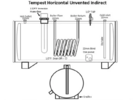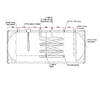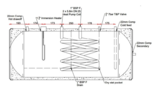To give you an idea of the internal setup of that cylinder -


As you can see ( 1st pic isn't really to scale as the immersion and coil would usually be smaller, relative to a 250L cylinder) their design isn't as efficient as a normal vertical cylinder will be at heating the water through convection and the immersion would take an awful long time to heat that volume of water up. That and the immersion's stat will usually shut it off a lot sooner and more than probably temp at the stat pocket (stat for the coil/CH system) reaches set point. Also, can I recommend you increase the cylinder stat to at least 55deg


As you can see ( 1st pic isn't really to scale as the immersion and coil would usually be smaller, relative to a 250L cylinder) their design isn't as efficient as a normal vertical cylinder will be at heating the water through convection and the immersion would take an awful long time to heat that volume of water up. That and the immersion's stat will usually shut it off a lot sooner and more than probably temp at the stat pocket (stat for the coil/CH system) reaches set point. Also, can I recommend you increase the cylinder stat to at least 55deg



